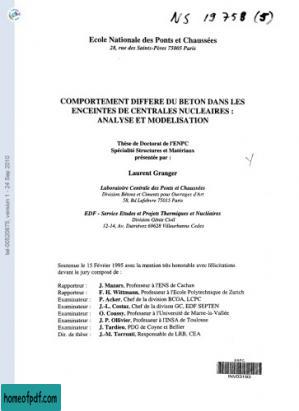COMPORTEMENT DIFFERE DU BETON DANS LES ENCEINTES DE CENTRALES NUCLEAIRES : ANALYSE ET MODELISATION
该资源由用户: 水珊少女 上传 举报不良内容

尊敬的读者:
欢迎您访问我们的网站。本站的初衷是为大家提供一个共享学习资料、交换知识的平台。每位用户都可以将文件上传至网盘并分享。
然而,随着用户上传的资料增多,我们发现部分不宜或版权问题的书籍被分享到了本站。
为此,我们已经关闭了分享入口,并进行了多次书籍审查,但仍有部分内容未能彻底审查到位。
在此,我们恳请广大读者与我们共同监督,如发现任何不宜内容,请 点击此处 进行举报,我们会第一时间处理并下架相关内容。
希望我们能共建一个文明社区!感谢您的理解与支持!
扫一扫即可关注本站(PDF之家)微信公众账号
发送您想要找的书籍名称即可找到书籍

本站为非盈利性网站, 但服务器成本高昂, 如果本站内容对您有帮助, 欢迎捐赠, 您的鼓励是我们最大的动力!
声明
本站资源来源于网络及个人用户网盘上传,仅用于分享知识,学习和交流! 本站不保存,不制作,不出售任何图书。请您下载完在24小时内删除。 资源禁用于商业用途!如果您喜欢本站资源,请购买正版,谢谢合作!
扫码支持一下:


猜你喜欢

《光电帝国:电力发展史上的巨人和他们的战争》[美]吉尔.琼斯全译修订版
View more
《陆王》池井户润
View more
编写可读代码的艺术 - Dustin Boswell and Trevor Foucher 著 尹哲 郑秀雯 译
View more
《材料科学基础》胡赓祥/蔡洵
View more
侯虹斌《女性进化论》
View more
《IDEO,设计改变一切》蒂姆•布朗(Tim Brown)
View more
《科技失控》温德尔·瓦拉赫
View more
《神农本草经·难经》扁鹊
View more
《我在华为的日子》董延明文字版
View more
《阿瑟·戈登·皮姆历险记》埃德加・爱伦・坡中文版
View more
《软文营销实战108招:小软文大效果》
View more
